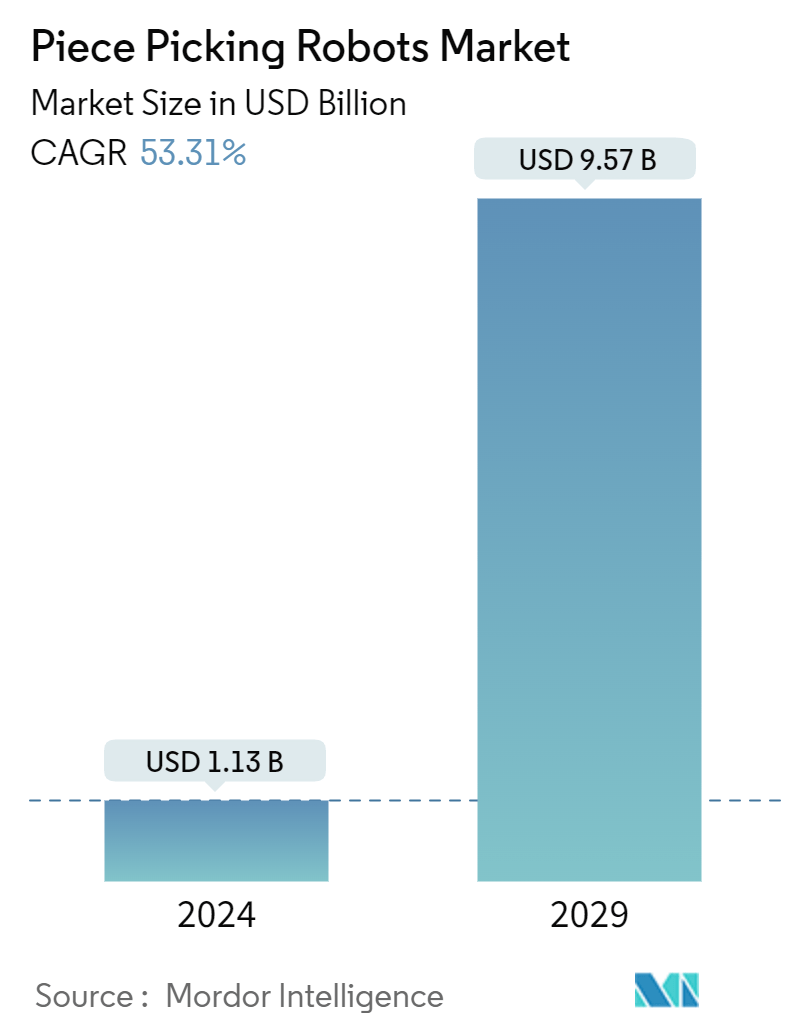Market Size of Piece Picking Robots Industry

| Study Period | 2019 - 2029 |
| Market Size (2024) | USD 1.13 Billion |
| Market Size (2029) | USD 9.57 Billion |
| CAGR (2024 - 2029) | 53.31 % |
| Fastest Growing Market | North America |
| Largest Market | Asia Pacific |
| Market Concentration | Low |
Major Players
*Disclaimer: Major Players sorted in no particular order |
Piece Picking Robots Market Analysis
The Piece Picking Robots Market size is estimated at USD 1.13 billion in 2024, and is expected to reach USD 9.57 billion by 2029, at a CAGR of 53.31% during the forecast period (2024-2029).
- Investment in automation is propelling the growth of piece-picking robots, particularly in sectors like e-commerce, logistics, and manufacturing. The push for enhanced efficiency, precision, scalability, and cost-effectiveness is driving this automation trend. Labor shortages in warehousing and logistics, exacerbated by the COVID-19 pandemic and surging e-commerce demands, have spurred heightened investments in automation. As a result, piece-picking robots are increasingly taking on labor-intensive roles, such as order picking, thereby diminishing the reliance on a vast workforce.
- In September 2024, Pickommerce, hailing from Meitar, Israel, clinched funding of USD 3.4 million. The company announced that this capital infusion would accelerate the development, production, and marketing of its flagship, the PickoBot piece-picking robot. Furthermore, Pickommerce underscored the escalating trend of automation in today's logistics hubs, noting that robots are now chiefly tasked with duties like crate collection and package unloading.
- As wages climb in various regions, businesses are increasingly leaning on robots to trim operational expenses. While the upfront investment in piece-picking robots and automation tech can be steep, the promise of long-term labor savings and the benefit of continuous, fatigue-free operation make it enticing. Moreover, Bank of America projects that by 2025, a significant 45% of all manufacturing will be dominated by robotics. In alignment with this trajectory, industry giants such as Raymond Limited, a prominent Indian textile firm, and Foxconn Technology Group, a key Chinese supplier for tech behemoths like Samsung, are poised to substitute 10,000 and 60,000 workers, respectively, with automation in their production facilities.
- Piece-picking robots demand a hefty upfront investment, presenting a notable hurdle to market growth. This investment is further magnified by the necessity for supportive infrastructure. Moreover, technical constraints of these robots—such as their slower speeds, difficulties gripping unconventional items, and concerns about reliability—hinder market expansion.
- Like other advanced technologies, piece-picking robots need regular maintenance, which can lead to operational downtime. To ensure these robots fit seamlessly into high-throughput industries, it's crucial to minimize such interruptions. Additionally, given the unique workflows and product types across various industries, there's a strong demand for customization. This need complicates the deployment of piece-picking solutions, increasing both time and costs.
- The ongoing Ukraine conflict has disrupted the supply chain for raw materials and components vital to manufacturing piece picking robots. Such disruptions can result in shortages, longer lead times, and increased costs, all of which directly influence the market. In response, companies might turn to alternative suppliers or bolster local production, potentially reshaping market dynamics and pricing. The persistent Russia-Ukraine tensions, coupled with China's "Zero Tolerance Policy," have spurred a notable rise in global inflation. This inflation surge has reverberated across various sectors, notably the electronic components and industrial automation industries, driving up component prices and stunting the studied market's growth. Furthermore, elevated inflation and interest rates have curtailed consumer spending, further constraining market expansion.
Piece Picking Robots Industry Segmentation
Piece-picking robots are competent in helping workers by eliminating the necessity for labor to be devoted to repetitive and critical tasks. These software-driven, hardware-enabled solutions handle the core task of picking and placing individual items as part of a wide range of workflows and processes. Piece-picking robots improve performance and efficiency in e-commerce order fulfillment and intralogistics.
The piece picking robots market is segmented by type of robot (collaborative, mobile and others), by end-user application (pharmaceutical, retail/warehousing/distribution centers/logistics centers, other end user applications), and by geography (North America, Europe, Asia Pacific, Rest of the World). The report offers market forecasts and size in value (USD) for all the above segments.
| By Type of Robot | |
| Collaborative | |
| Mobile and others |
| By End User Application | |
| Pharmaceutical | |
| Retail/Warehousing/Distribution Centers/Logistics Centers | |
| Other End User Applications |
| By Geography*** | |
| North America | |
| Europe | |
| Asia | |
| Australia and New Zealand | |
| Latin America | |
| Middle East and Africa |
Piece Picking Robots Market Size Summary
The piece picking robots market is experiencing rapid expansion, driven by the increasing demand for automation in manufacturing and logistics sectors. This growth is largely attributed to the need for faster and more efficient warehouse operations, as traditional methods are becoming less viable due to labor shortages and rising operational costs. The adoption of piece picking robots is seen as a solution to these challenges, offering benefits such as reduced pick times and minimized labor requirements. The market is characterized by the integration of advanced technologies like artificial intelligence and autonomous control, which are enhancing the capabilities of these robots. Companies are increasingly recognizing the advantages of robotics, leading to a significant rise in installations and investments in automated solutions.
The market landscape is highly competitive, with major players like Plus One Robotics Inc., Kindred Systems Inc., and Universal Robots A/S actively engaging in partnerships and acquisitions to strengthen their market position. Collaborative robots, or cobots, are gaining traction due to their ability to work alongside human workers, improving accuracy and reducing errors in tasks such as material handling and assembly. The declining costs of these robots are making them more accessible, further driving their adoption across various industries. The North American region, in particular, is witnessing substantial growth due to the increasing deployment of piece picking robots in warehouses and e-commerce fulfillment centers. As businesses continue to seek ways to enhance productivity and efficiency, the piece picking robots market is poised for significant growth in the coming years.
Piece Picking Robots Market Size - Table of Contents
-
1. MARKET INSIGHTS
-
1.1 Market Overview
-
1.2 Industry Attractiveness - Porters Five Forces Analysis
-
1.2.1 Bargaining Power of Suppliers
-
1.2.2 Bargaining Power of Buyers
-
1.2.3 Threat of New Entrants
-
1.2.4 Threat of Substitutes
-
1.2.5 Intensity of Competitive Rivalry
-
-
1.3 Industry Value Chain Analysis
-
1.4 Assessment of Impact of COVID-19 on the Automation Industry
-
1.5 Piece-picking Robot Software Technology and Evolution
-
-
2. MARKET SEGMENTATION
-
2.1 By Type of Robot
-
2.1.1 Collaborative
-
2.1.2 Mobile and others
-
-
2.2 By End User Application
-
2.2.1 Pharmaceutical
-
2.2.2 Retail/Warehousing/Distribution Centers/Logistics Centers
-
2.2.3 Other End User Applications
-
-
2.3 By Geography***
-
2.3.1 North America
-
2.3.2 Europe
-
2.3.3 Asia
-
2.3.4 Australia and New Zealand
-
2.3.5 Latin America
-
2.3.6 Middle East and Africa
-
-
Piece Picking Robots Market Size FAQs
How big is the Piece Picking Robots Market?
The Piece Picking Robots Market size is expected to reach USD 1.13 billion in 2024 and grow at a CAGR of 53.31% to reach USD 9.57 billion by 2029.
What is the current Piece Picking Robots Market size?
In 2024, the Piece Picking Robots Market size is expected to reach USD 1.13 billion.

